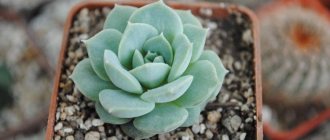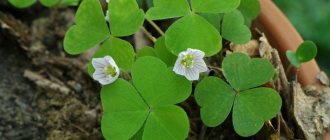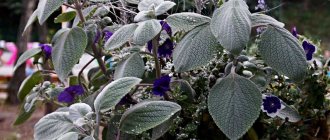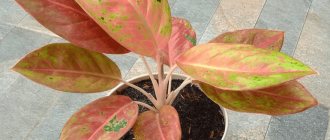In nature, there are cacti that are afraid of the sun, love water and have no spines. Such a cactus is called Schlumbergera, or Decembrist, or zygocactus. This plant is part of a genus of epiphytic South American cacti that grow on woody branches in tropical forests. Zygocactus blooms when there is a tropical summer in its homeland, namely in November or December, and flowering ends in the last days of January. Decembrist was brought to the middle latitudes in 1816 by the collector Allan Cunningham.
Brief description of cultivation
- Bloom . It is observed in winter, or more precisely, in December–January.
- Illumination . Slight shading or bright but diffused light. Windows with an eastern or western orientation are perfect, but if the pot is placed on a southern windowsill, then the flower will need shading during lunch hours.
- Temperature regime . Zygocactus is able to grow normally at temperatures from 18 to 40 degrees. But in summer, the flower grows and develops best at an air temperature of 18 to 22 degrees, and in winter - from 14 to 16 degrees.
- Watering . Moisten the soil mixture in the pot moderately after its surface has dried to a depth of 10–30 mm.
- Air humidity . It should be elevated. To do this, in the summer the bush must be moistened with a sprayer several times a week; in the winter months, the number of sprays is reduced to 1-2 every 30 days.
- Fertilizer . Feed the flower once every half month from March to September. To do this, use a mineral complex fertilizer for cacti.
- Rest period . It is observed in October–November.
- Transplant . Young bushes are replanted regularly once a year, adult plants are replanted less frequently, or rather, once every 5 or 6 years.
- Trimming . To form the crown of the bush, unnecessary segments are carefully torn off by hand.
- Reproduction . Cuttings and grafting.
- Harmful insects . Spider mites, scale insects and mealybugs.
- Diseases . Phythium, late blight, fusarium, and also damage by bacteria of the Erwinia group.
Rules of care
Caring for zygocactus at home is not difficult, the main thing is to create conditions that are close to natural. The Decembrist loves bright rooms and long daylight hours. It is better to shade the shoots from the direct rays of the midday sun, especially in summer. The flower grows well on windowsills facing east or west, as well as in southern rooms. With a lack of light, zygocactus does not bloom or produces a very small number of buds.
At the end of flowering, the Decembrist needs a period of rest. The plant is placed in a cool room, provided with short daylight hours and moderate watering. The flower is kept in this state for 1-2 months.
The optimal air temperature is +18…+22°C. It is advisable to maintain it throughout the year. In winter, slight cold snaps are allowed, but not below +13°C. To avoid intense heat in summer, you can take the flower to the balcony or garden. It is important to protect the zygocactus from drafts and sudden cold spells at night.
The air humidity in the room where the zygocactus grows should be above average. The plant receives moisture from the air, so it is necessary to spray the shoots more often or place pallets with wet pebbles nearby.
Zygocactus should be watered sparingly. When the earthen ball dries 2-4 cm, the soil is watered abundantly with purified and warm water. The roots are very sensitive to fungal diseases, so it is important to ensure good drainage to remove excess liquid.
Zygocactus needs small doses of fertilizing. During the period of active growth and flowering, fertilizer for flowering plants is added to the soil monthly.
It is recommended to prune Zygocactus immediately after flowering. Part of the young shoots at the junction of the lobes should be removed. This promotes branching and abundant flowering, because buds form only at the ends of young shoots.
Features of zygocactus
Decembrist differs from many house flowers in that it blooms at a time when most plants have a dormant period. Such a plant has other features that the gardener must know about:
- The flower is not recommended to be grown on windowsills of western and southern orientation, since due to too much bright light, the final fragments of the stems may begin to die off on the bush.
- In summer, the plant needs a large amount of fresh air. Therefore, at this time it is recommended to move it to a loggia, balcony or terrace, and you need to choose a place for it that is in the shade.
- In the summer, zygocactus responds very well to a warm shower. If you don’t have time for this, then at least systematically moisten the bush with a sprayer.
- If the Decembrist is provided with good care and suitable conditions for growth, then it will be able to grow normally and bloom regularly for 15–20 years.
- Schlumbergera is one of those flowers that it is better not to disturb during the formation of buds. The flower pot cannot be moved to another place or even rotated, as this may cause the buds to drop.
- If desired, zygocactus can be grown not only as an ordinary indoor flower, but also as an hanging plant.
How to make “Decembrist” bloom - Everything will be fine
Diseases of zygocactus problems when growing
Zygocacti of any kind are not susceptible to insect attack. Infestation by red mites or slugs sometimes occurs, but with good care this is rare. Aphids and scale insects can also appear on leaves when there is excess soil and air moisture; these pests can be easily eliminated with a soap solution or spraying with chemicals .
For succulent plants, fungal infections and rot pose a danger. Fungi begin to infect the plant from the root; brown spots with a characteristic odor and soft to the touch may appear on the stems. Then the fungal spores spread to the entire bush, and it dies.
You can get rid of the fungus only by removing the affected shoots and replanting the bush in another soil. It is better to destroy the previous pot, soil and affected plants so that they do not infect other plants on the windowsill.
Fungicides are used to treat and prevent succulent plants. Choose drugs that contain the active substances chlorothalonil or benomyl, they are the most effective. In general, if you monitor the plant and provide it with good care, then there will be no problems with growing Rozhdestvennik.
Leave a review and get a plus for your site karma:
Caring for the Decembrist at home
Watering and air humidity
The features of growing Decembrist under indoor conditions are radically different from those recommended for cultivating other cacti. Most of the care rules are similar to those that apply when cultivating ordinary deciduous houseplants. For example, if you forget to moisten the substrate in a pot with a cactus in time, then nothing bad will happen because of this. But the zygocactus should be watered systematically, and warm, well-settled water is used for this. It can also suffer due to too dry air in the room, so it is recommended to systematically moisten the bush with a spray bottle. You can also increase air humidity by placing a pot with a plant on a tray into which moistened pebbles are poured.
Illumination and temperature
Ordinary cacti tolerate direct sunlight well, but Schlumbergera can suffer greatly from it, so it requires mandatory shading. But it is not demanding on temperature, but grows and develops best during the growing season in cool conditions (from 18 to 22 degrees).
Fertilizer
They begin to feed the flower in March; for this purpose, complex mineral fertilizer for cacti is added to the soil mixture once a month, using half the dose recommended by the manufacturer on the packaging. In the summer, after the shoots begin to grow and develop intensively, the frequency of fertilizing is increased to twice every 30 days. With the onset of September, they stop adding fertilizers to the substrate. Experienced gardeners recommend systematically treating the bush with a fungicide solution to protect it from fungal diseases.
Trimming
Formative pruning of the flower is carried out in June. To do this, do not cut off the excess part, but carefully unscrew it by hand. As a rule, shoots that are too long, as well as those that grow incorrectly, are pruned. In addition to the fact that after pruning the bush looks more impressive, this also has a positive effect on its flowering, which becomes more luxuriant.
Decembrist transplant
Decembrist is replanted in the last days of February after it has completely faded. Young bushes are replanted once a year, and adult bushes are replanted once every 4 or 5 years. Since zygocactus has a superficial root system, a low but wide pot is used for planting it. A drainage layer is made at the bottom of the pot, the thickness of which should be equal to 1/3 of the height of the container. For replanting, use ready-made purchased soil mixture for cacti. In order to prepare the soil mixture with your own hands, you need to combine leaf and turf soil, as well as sand (2:1:1). Then a little expanded clay or brick chips are added to the mixture for looseness, as well as quite a bit of charcoal powder for disinfection. The resulting substrate should be slightly acidic.
Decembrist. Replanting into new soil. Experiment with pine bark.
Reproduction of the Decembrist
Most often, indoor zygocactus is propagated by cuttings. To begin with, you need to unscrew two or three outer “links” from the stem, after which they are left in the fresh air for several days, where they should dry well. For rooting, the cuttings are planted in a moistened substrate, and on top they are covered with a cut plastic bottle or a transparent glass jar. Place the cuttings in a shaded place and provide them with systematic ventilation and coolness (from 15 to 20 degrees).
Most often, propagation by cuttings is carried out after Schlumbergera has been pruned, since after this procedure a large number of finished cuttings may remain.
Reproduction of Schlumbergera. How to propagate Decembrist.
Reproduction of the Decembrist flower
Obtaining young specimens of Schlumbergera is possible in two ways: by seeds and individual parts of the stem. The procedure should be carried out in the spring.
The simplest and most accessible is propagation by shoots. You should carefully break off a part of a healthy, young stem along the border of the articulation. The main thing is that the process must have at least 3 segments.
The grower himself must decide how to plant the shoot. You can root the cuttings in water and then plant them in a flowerpot, or you can dry them until a film forms and immediately place them in a substrate for rooting at the site of future growth.
Reproduction of Decembrist by seeds is a more labor-intensive process. To figure out how to grow a healthy plant from seeds, you need to take the advice of experienced cactus growers.
The first stage is obtaining a seed by cross-pollinating two flowers. The seeds will ripen in approximately 8 months.
The second stage is peeling the seeds from the fruit skin, treating them with disinfectants and planting them in a substrate without covering them with soil. To guarantee germination, you can build a mini-greenhouse.
Pests and diseases of the Decembrist
Diseases
Zygocactus may suffer from fungal diseases, for example, phytium, fusarium or late blight. The causative agents of these diseases can be found in a poorly prepared substrate, from which they penetrate into the flower, and the root collar of the plant is the first to be damaged. The affected bush becomes faded and has a grayish tint, and segments begin to die off. As a result, the flower begins to fade even with systematic watering. In order to get rid of fusarium, the Decembrist is treated with a solution of a special fungicidal agent, and if it is affected by late blight and phytium, the bush is sprayed with Topaz, Maxim or Vitaros.
Harmful insects
The appearance of a rusty coating on the surface of the bush may indicate that a spider mite has settled on it. It is a very small insect with a yellow, brown or pale red color that is almost impossible to see with the naked eye. Mites appear where there is very low air humidity for a long time. To destroy such a pest, the bush is sprayed with Fitoverm, Actellik or Neoron.
If you see white lumps between the stems that look like cotton wool, then this is a sure sign that mealybugs have settled on the flower. In order to get rid of them, treat the bush with Aktara solution.
Possible problems
If zygocactus is not properly cared for, problems may arise, for example:
- Wilting of the bush . The wilting of the plant may be due to the fact that it is affected by phytium or late blight. Also, shoots may become sluggish due to disease of the root system. If the trunk of the bush sways and has become unstable, this may be due to the fact that the roots of the flower have already died as a result of hypothermia (the room is too cold or the bush was watered with very cold water). The roots could also die because the pot overheated in the sun. A very high concentration of fertilizer solution can also severely damage the root system. In this case, the Decembrist is immediately transplanted into fresh soil mixture, otherwise the concentrated solution may completely burn the roots.
- Lack of flowering . Zygocactus will not bloom until it senses that it is time to bloom. For this to happen, the flower needs to be provided with a full period of rest. To do this, from the last days of September to the end of November, the plant is transferred to a cold room, during this time it is not fed and watered very rarely and with a small amount of water (make sure that the lump of earth in the pot does not dry out). In the last days of November, move the Decembrist to a warm and well-lit place, and begin to water it systematically. Rotate the bush regularly around its axis, thanks to this all its sides will be illuminated evenly. After the buds appear, do not allow the clod of earth in the pot to dry out, and do not turn or move the bush to another place, otherwise all the buds may fly off. If everything is done correctly, then the zygocactus will undoubtedly delight you with lush flowering.
- Dying and flying around of segments . In some cases, the leaves of a seemingly perfect healthy bush may begin to die and fall off. Most often, the death of segments is due to the fact that a spider mite has settled on the bush. If the pest was not found, then the “leaf fall” may be due to a lack of nutrients (too poor substrate or very infrequent feeding). In this case, the bush needs to be fed 1–2 times leaf by leaf with a fertilizer solution for epiphytic cacti, then it is added to the substrate. If, even after such feeding, the falling of the segments continues, then the plant will have to be replanted in a fresh soil mixture. If the terminal segments fly around, the reason for this may be excessively low air humidity or stress (change in environment, sharp fluctuations in daily temperatures, untimely transplantation or draft).
DECEMBER (Schlumberger) why do the leaves fall? Growing problems and plant diseases!
Preparation of planting material and propagation
Zygocactus is a flower that is easy to care for at home, even when it comes to propagating the plant. For example, you can take a cutting from an adult cactus. Cuttings on which 2-3 stem fragments have already formed are suitable for growing.
Such planting material must be carefully separated from the main plant. It is better to do this in mid-spring, when it is already quite warm. After this, the cutting must be left in a dark place for several days, and it will be ready for planting.
Zygocactus flower: growing from seeds
Propagation by seeds is a little more complicated. You can purchase them at a flower shop or grow them yourself. However, this will require pollination of the zygocactus.
The algorithm for preparing planting material using this method is as follows:
- 2-3 days after the plant begins to bloom, it is necessary to pick a flower from one cactus and pollinate the flower of another with it. To do this, simply immerse the pestle in pollen. If the flowers have not yet bloomed on the second Decembrist, then the already picked flower can be safely preserved for up to 2-3 weeks. During this time, it will not lose its pollinating properties.
- Thanks to pollination, a fruit should appear on the cactus. It is a small berry. The fruit ripens only in 6-8 months. Until this moment you cannot touch it.
- When the berry becomes soft enough to the touch, it must be picked and cleaned of seeds.
- After this, the planting material must be washed in a weak solution of potassium permanganate.
Types of Decembrist with photos and names
Buckley
The Decembrist variety "Bakley" is considered the most persistent. It withstands changes of environment and some lack of care well. "Bakley" grows 40-50 centimeters, resulting in a large and lush bush. The Decembrist variety has large buds. They can reach eight centimeters in length.
Decembrist flower variety "Bakley" is distinguished by a variety of colors. They can be of different colors. But the leaves are always dark green.
This zygocactus blooms from November to March. Such a long period of bud formation cannot but please.
White
Decembrist variety “White” looks very gentle and at the same time elegant. Usually such a plant blooms profusely. Sometimes the stems and leaves are not visible under the buds. "White" has large flowers.
Truncated
This species of zygocactus is characterized by light green, pointed leaves and a variety of flowers. The stems of the plant reach six centimeters and have teeth on the edge.
Decembrist flowers “Truncated” are two-tiered. They have petals bent back. The colors of this zygocactus are very diverse. The buds can be purple, white, pink, orange or a combination of colors. That is why this variety is especially popular.
Rousseliana
This Decembrist grows no higher than thirty centimeters. Its leaves are flat and glossy. It is worth noting that this variety of zygocactus does not have needles, which makes it very cute. The peduncle tube of this plant variety is green. The buds themselves can be red, pink, purple. The short stature and abundance of colors make the Rousseliana variety very attractive. He can decorate any room.
It is also resistant to negative environmental factors. This makes it popular among the population, because the unpretentious plant is easier to care for.
Golden Cream
This Decembrist variety is very interesting. The fact is that it has yellow inflorescences. Moreover, their shade is gentle and pleasant, just like sunny. It is worth noting that in nature Decembrists do not bloom yellow. But the breeders tried their best and developed this species. They had to work for a long time, the task before them was not an easy one. Still, they managed to create a warm, sunny Decembrist.
Aspen
This zagocactus is double. It blooms white and pale pink. The stamens of the plant are yellow. Decembrist of this variety is a bit like a carnation when flowering. He looks very solemn. It is good to place such a plant in a room where there is a lot of space and the flower can appear in all its glory.
Characteristics and history
Schlumbergera has many names among the people: Decembrist, Rozhdestvennik, Zygocactus, Varvarin color.
Ripsalidopsis, which is very similar in appearance, is often mistakenly included in it (read about the differences between Schlumbergera from ripsalidopsis and other similar plants, and how not to confuse them, here). This is a relative of the Decembrist, but only a beginning florist can call them identical.
Schlumbergera has elongated segments with jagged or rounded projections along the edges.
Ripsalidopsis does not have scalloped or jagged segments.
Decembrist blooms at Christmas , and ripsalidopsis at Easter , hence its popular name - Easter flower .
However, both the appearance and care requirements of these plants are quite spartan. Both require a dormant period, that is, being in a cool place with little or no watering, otherwise you may not see flowers.
Previously, Decembrists were found in nature only with red and white flowers. The remaining Schlumberger varieties are the result of the work of breeders .
Quite inconspicuous in summer, this zygocactus surprisingly transforms in winter, during the flowering period.
Below you will see photos of varieties of flowers and types of Decembrist.
Reproduction: how to root a cutting
Christmas cactus is propagated by cuttings; this is done on the eve of the growing season, at the end of spring, beginning of summer. You will need:
- adult zygocactus,
- light soil substrate for rooting,
- small containers, for example, transparent plastic cups.
To obtain new plants, you can take pieces of the stem that remained after the formation of the bush or specially prepare cuttings. It is enough to separate two or three segments. The breeding procedure is as follows:
- We separate the cuttings with our hands, as if twisting them from the stem.
- Dry for two to three days before planting.
- Place the dried segments in a glass with a moistened substrate, slightly deepening them.
- We cover the cuttings with a second glass, creating something like a greenhouse.
- We place the cups with seedlings in a warm, bright place, without open sun.
- We regularly ventilate the greenhouse and moisten the substrate.
- We carefully transplant the rooted plant into a small pot for a permanent place of residence.
Young Decembrists are able to bloom in the second year
Preparing the soil and planting site
In nature, cacti of this type often grow in crevices of large trees. They hook their roots onto the bark and receive all the necessary nutrients. Therefore, zygocactus does not need a large and powerful rhizome.
Drainage should be placed at the bottom of the zygocactus pot
Accordingly, even in indoor conditions, a small pot is sufficient for the plant. A third of its volume must be occupied by drainage (expanded clay, broken brick or small stones).
The soil can be purchased at a specialty store. But even the ready-made mixture for cacti is recommended to be mixed ¼ with coarse sand. It is recommended to pour boiling water over it first to disinfect it.
Some people also prepare the soil mixture themselves. To do this, you need to mix 1 part turf soil, 2 parts sand and the same amount of peat. To the resulting mixture you need to add 4 parts of leaf soil and 6 parts of humus. Or you can prepare your own composition. The main thing is that the resulting soil is sufficiently loose, with a pH value of about 5-6.











